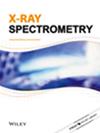Energy dependence of x‐ray beam size produced by polycapillary x‐ray optics
IF 1.5
4区 物理与天体物理
Q3 SPECTROSCOPY
引用次数: 0
Abstract
In this work, we studied the x‐ray energy dependence of x‐ray beam diameter focused by polycapillary optics. A quantitative beam diameter–energy relation enables more accurate estimation of the element‐specific interrogation area of a sample using the compositional maps produced by a micro‐XRF system. This improves upon our ability to visualize individual beam‐diameter sized mineral grains and in turn directly benefits Planetary Instrument for X‐ray Lithochemistry (PIXL) analyses of martian soil in addition to benefitting other micro‐focused x‐ray fluorescence (XRF) systems. The spatial distribution of an array of characteristic XRF emission lines was measured by sampling via a knife‐edge approach with small motor stepping of the beam across target edges. Data taken as part of this effort, from the Planetary Flight Model (PFM), were limited to only seven beam energies corresponding to the elements Ni, Cu, Se, Ta, Au, Ti and Ba. Hence, we conducted additional analysis using JPL's lab‐based breadboard (LBB) micro‐XRF system, a system that emulates PIXL's functionality where we measured beam diameter corresponding to 18 elements: Na, Mg, Al, Si, Cl, Ca, Ti, Cr, Mn, Fe, Ni, Cu, Zn, Ga, Ge, Se, Sr and Mo. The experimental results were also compared with Monte Carlo simulations. The beam diameter (聚毛细管 X 射线光学器件产生的 X 射线束尺寸的能量依赖性
在这项工作中,我们研究了聚毛细管光学系统聚焦的 X 射线束直径与 X 射线能量的关系。通过定量的光束直径-能量关系,可以利用微型 XRF 系统产生的成分图更准确地估计样品的特定元素探测区域。这提高了我们对单个光束直径大小的矿物颗粒进行可视化的能力,进而直接有益于行星 X 射线岩石化学仪器(PIXL)对火星土壤的分析,并有益于其他微聚焦 X 射线荧光(XRF)系统。通过在目标边缘使用小电机步进光束的刀刃取样方法,对特征 XRF 发射线阵列的空间分布进行了测量。作为这项工作的一部分,从行星飞行模型(PFM)中获取的数据仅限于与 Ni、Cu、Se、Ta、Au、Ti 和 Ba 元素相对应的七种光束能量。因此,我们使用 JPL 的实验室面包板 (LBB) micro-XRF 系统进行了额外的分析,该系统可模拟 PIXL 的功能,我们在该系统中测量了与 18 种元素相对应的光束直径:我们测量了 18 种元素对应的光束直径:Na、Mg、Al、Si、Cl、Ca、Ti、Cr、Mn、Fe、Ni、Cu、Zn、Ga、Ge、Se、Sr 和 Mo。实验结果还与蒙特卡洛模拟结果进行了比较。我们为 LBB 得到的光束直径(y)-能量(x)关系式为 y = 185.79 exp(-0.078x),然后利用其指数分量为 PFM 得到了更精确的关系式,即使数据集有限:y = 227.53 exp(-0.078x)。PFM 和 LBB 两个系数的差异主要源于聚毛细管光学设计的不同,这项工作为这两个系统定量地建立了 X 射线束直径与能量的关系。
本文章由计算机程序翻译,如有差异,请以英文原文为准。
求助全文
约1分钟内获得全文
求助全文
来源期刊

X-Ray Spectrometry
物理-光谱学
CiteScore
3.10
自引率
8.30%
发文量
38
审稿时长
6-12 weeks
期刊介绍:
X-Ray Spectrometry is devoted to the rapid publication of papers dealing with the theory and application of x-ray spectrometry using electron, x-ray photon, proton, γ and γ-x sources.
Covering advances in techniques, methods and equipment, this established journal provides the ideal platform for the discussion of more sophisticated X-ray analytical methods.
Both wavelength and energy dispersion systems are covered together with a range of data handling methods, from the most simple to very sophisticated software programs. Papers dealing with the application of x-ray spectrometric methods for structural analysis are also featured as well as applications papers covering a wide range of areas such as environmental analysis and monitoring, art and archaelogical studies, mineralogy, forensics, geology, surface science and materials analysis, biomedical and pharmaceutical applications.
 求助内容:
求助内容: 应助结果提醒方式:
应助结果提醒方式:


